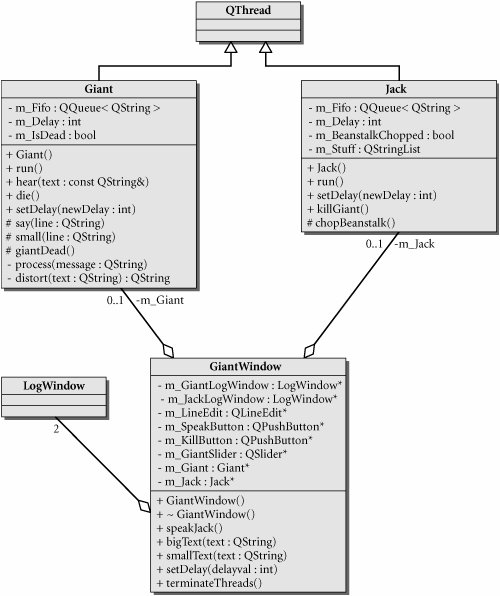Qt Slots Thread Safe
Processed and the thread will be blocked forever. Qt detects this at run time and prints a warning, but does not attempt to fix the problem for you. It has been suggested that Qt could then just do a normal DirectConnectionif both objects are in the same thread. But we choose not to because BlockingQueuedConnectionis something that can only be. So, although the signals are thread-safe, you still have to protect everything in the application. I understand that with boost::iocontext you are able to post work for processing on a different thread in a similar way that Qt event management system handles the emission of signals and calling of slots (I think?). Qt Signal Slot Thread Safe Some examples of the games you will find are listed below. Table Games – The all-time classics! Live Casino – As close to a real-life casino Qt Signal Slot Thread Safe you can get! New Slots Machines – The 200-year-old one-armed bandit! Video Slots – Bringing the game to life! Yes, this is fine as long as you guarantee that the construction and destruction are not concurrent between different threads.
- Qt Slots Thread Safety
- Qt Signal Thread
- Qt Thread Signal Slot
- Qt Slots Thread Safe List
- Qt Slots Thread Safe Code
- Qt Thread Pool
This blog is part of a series of blogs explaining the internals of signals and slots.
In this article, we will explore the mechanisms powering the Qt queued connections.
Summary from Part 1
Qt Slots Thread Safety
In the first part, we saw that signalsare just simple functions, whose body is generated by moc. They are just calling QMetaObject::activate, with an array of pointers to arguments on the stack.Here is the code of a signal, as generated by moc: (from part 1)
QMetaObject::activatewill then look in internal data structures to find out what are the slots connected to that signal.As seen in part 1, for each slot, the following code will be executed:
So in this blog post we will see what exactly happens in queued_activateand other parts that were skipped for the BlockingQueuedConnection
Qt Event Loop
A QueuedConnection will post an event to the event loop to eventually be handled.
When posting an event (in QCoreApplication::postEvent),the event will be pushed in a per-thread queue(QThreadData::postEventList).The event queued is protected by a mutex, so there is no race conditions when threadspush events to another thread's event queue.
Once the event has been added to the queue, and if the receiver is living in another thread,we notify the event dispatcher of that thread by calling QAbstractEventDispatcher::wakeUp.This will wake up the dispatcher if it was sleeping while waiting for more events.If the receiver is in the same thread, the event will be processed later, as the event loop iterates.
The event will be deleted right after being processed in the thread that processes it.
An event posted using a QueuedConnection is a QMetaCallEvent. When processed, that event will call the slot the same way we call them for direct connections.All the information (slot to call, parameter values, ...) are stored inside the event.
Copying the parameters
The argv coming from the signal is an array of pointers to the arguments. The problem is that these pointers point to the stack of the signal where the arguments are. Once the signal returns, they will not be valid anymore. So we'll have to copy the parameter values of the function on the heap. In order to do that, we just ask QMetaType. We have seen in the QMetaType article that QMetaType::create has the ability to copy any type knowing it's QMetaType ID and a pointer to the type.
To know the QMetaType ID of a particular parameter, we will look in the QMetaObject, which contains the name of all the types. We will then be able to look up the particular type in the QMetaType database.
queued_activate
We can now put it all together and read through the code ofqueued_activate, which is called by QMetaObject::activate to prepare a Qt::QueuedConnection slot call.The code showed here has been slightly simplified and commented:
Upon reception of this event, QObject::event will set the sender and call QMetaCallEvent::placeMetaCall. That later function will dispatch just the same way asQMetaObject::activate would do it for direct connections, as seen in Part 1
BlockingQueuedConnection
BlockingQueuedConnection is a mix between DirectConnection and QueuedConnection. Like with aDirectConnection, the arguments can stay on the stack since the stack is on the thread thatis blocked. No need to copy the arguments.Like with a QueuedConnection, an event is posted to the other thread's event loop. The event also containsa pointer to a QSemaphore. The thread that delivers the event will release thesemaphore right after the slot has been called. Meanwhile, the thread that called the signal will acquirethe semaphore in order to wait until the event is processed.
It is the destructor of QMetaCallEvent which will release the semaphore. This is good becausethe event will be deleted right after it is delivered (i.e. the slot has been called) but also whenthe event is not delivered (e.g. because the receiving object was deleted).

A BlockingQueuedConnection can be useful to do thread communication when you want to invoke afunction in another thread and wait for the answer before it is finished. However, it must be donewith care.
The dangers of BlockingQueuedConnection
You must be careful in order to avoid deadlocks.
Obviously, if you connect two objects using BlockingQueuedConnection living on the same thread,you will deadlock immediately. You are sending an event to the sender's own thread and then are locking thethread waiting for the event to be processed. Since the thread is blocked, the event will never beprocessed and the thread will be blocked forever. Qt detects this at run time and prints a warning,but does not attempt to fix the problem for you.It has been suggested that Qt could then just do a normal DirectConnection if both objects are inthe same thread. But we choose not to because BlockingQueuedConnection is something that can only beused if you know what you are doing: You must know from which thread to what other thread theevent will be sent.
The real danger is that you must keep your design such that if in your application, you do aBlockingQueuedConnection from thread A to thread B, thread B must never wait for thread A, or you willhave a deadlock again.
When emitting the signal or calling QMetaObject::invokeMethod(), you must not have any mutex lockedthat thread B might also try locking.
A problem will typically appear when you need to terminate a thread using a BlockingQueuedConnection, for example in thispseudo code:
You cannot just call wait here because the child thread might have already emitted, or is about to emitthe signal that will wait for the parent thread, which won't go back to its event loop. All the thread cleanup information transfer must only happen withevents posted between threads, without using wait(). A better way to do it would be:
The downside is that MyOperation::cleanup() is now called asynchronously, which may complicate the design.
Conclusion
This article should conclude the series. I hope these articles have demystified signals and slots,and that knowing a bit how this works under the hood will help you make better use of them in yourapplications.
EnArBgDeElEsFaFiFrHiHuItJaKnKoMsNlPlPtRuSqThTrUkZh
Threads in an operating system are a very simple thing. Write a function, maybe bundle it with some data and push it onto a newly created thread. Use a mutex or other method to safely communicate with the thread if necessary. Whether it are Win32, POSIX or other threads, they all basically work the same and are quite fool-proof.
Those who have discovered the joys of the Qt framework may assume that threads in Qt are just like this, and they would be right. However, there are several different ways to use threads in Qt, and it might not be obvious which approach to choose. The article, Multithreading Technologies in Qt, compares the different approaches.
The rest of this article demonstrates one of these methods: QThread + a worker QObject. This method is intended for use cases which involve event-driven programming and signals + slots across threads.
Usage with Worker class
The main thing in this example to keep in mind when using a QThread is that it's not a thread. It's a wrapper around a thread object. This wrapper provides the signals, slots and methods to easily use the thread object within a Qt project. To use it, prepare a QObject subclass with all your desired functionality in it. Then create a new QThread instance, push the QObject onto it using moveToThread(QThread*) of the QObject instance and call start() on the QThread instance. That's all. You set up the proper signal/slot connections to make it quit properly and such, and that's all.
Declare Worker class
For a basic example, check this class declaration for the Worker class:
class Worker : public QObject {
public:
public slots:
signals:

private:
};
We add at least one public slot which will be used to trigger the instance and make it start processing data once the thread has started. Now, let's see what the implementation for this basic class looks like.
Worker::Worker() { // Constructor
Qt Signal Thread
}

Worker::~Worker() { // Destructor
}
void Worker::process() { // Process. Start processing data.
}
While this Worker class doesn't do anything special, it nevertheless contains all the required elements. It starts processing when its main function, in this case process(), is called and when it is done it emits the signal finished() which will then be used to trigger the shutdown of the QThread instance it is contained in.
By the way, one extremely important thing to note here is that you should NEVER allocate heap objects (using new) in the constructor of the QObject class as this allocation is then performed on the main thread and not on the new QThread instance, meaning that the newly created object is then owned by the main thread and not the QThread instance. This will make your code fail to work. Instead, allocate such resources in the main function slot such as process() in this case as when that is called the object will be on the new thread instance and thus it will own the resource.
Create a new Worker instance
Now, let's see how to use this new construction by creating a new Worker instance and putting it on a QThread instance:
QThread* thread = new QThread;Worker* worker = new Worker();worker->moveToThread(thread);connect(worker, SIGNAL (error(QString)), this, SLOT (errorString(QString)));connect(thread, SIGNAL (started()), worker, SLOT (process()));connect(worker, SIGNAL (finished()), thread, SLOT (quit()));connect(worker, SIGNAL (finished()), worker, SLOT (deleteLater()));connect(thread, SIGNAL (finished()), thread, SLOT (deleteLater()));thread->start();
The connect() series here is the most crucial part. The first connect() line hooks up the error message signal from the worker to an error processing function in the main thread. The second connects the thread's started() signal to the processing() slot in the worker, causing it to start.
Qt Thread Signal Slot
Then the clean-up: when the worker instance emits finished(), as we did in the example, it will signal the thread to quit, i.e. shut down. We then mark the worker instance using the same finished() signal for deletion. Finally, to prevent nasty crashes because the thread hasn't fully shut down yet when it is deleted, we connect the finished() of the thread (not the worker!) to its own deleteLater() slot. This will cause the thread to be deleted only after it has fully shut down.
Qt Slots Thread Safe List
External Links
Qt Slots Thread Safe Code
- Maya Posch's blog, http://mayaposch.wordpress.com/2011/11/01/how-to-really-truly-use-qthreads-the-full-explanation/
- Qt Blog on subclassing QThread is wrong, [1]
- Woboq Blog on subclassing QThread is not always wrong, [2]